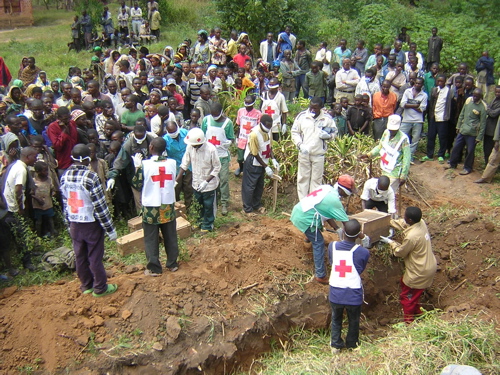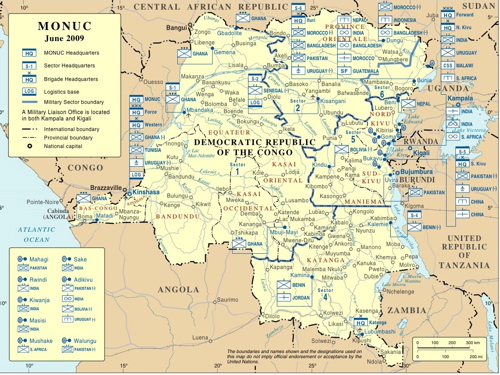The Special Rapporteur of the United Nations Commission on Human Rights, Philip Alston, described some of the heinous crimes committed against Congolese citizens after an investigation in eastern DRC. His statements support Human Rights Watch and other accounts that have surfaced in recent months relating atrocities committed by the Congolese regular army (FARDC) and Rwandan Hutu rebels (FDLR) against innocent civilians. The cooperative military agreement (Kimia II) between FARDC and the regular Rwandan army against the FDLR, supported by UN peacekeepers, has been a total failure. Satellite photos released this week clearly show the extent of the campaign against civilians.

Image: Village Burial from HRW
Alston adds to the infinite list of atrocities, and he reports that Congolese army troops shot and beat to death 50 Rwandan villagers and burned their refugee camp at Shalio. 40 women were abducted. Ten who escaped reported being gang-raped and having pieces of their breasts cut off. The government troops involved were newly integrated rebels under the command of Colonel Zimulinda, who Alston says orchestrated the massacre. Zimulinda has also been implicated in the Kiwanja Massacre of 2008.
In a stunning example of a government washing its hands of responsibility, DR Congo's Information Minister Lambert Mende said the authorities were "aware of the massacre" but would not arrest Zimulinda because they feared the consequences would be too great.
This response is a total and abhorrent abdication of moral responsibility, considering that Zimulinda is a blood relative of noted war criminal Bosco Ntaganda, who is now in charge of FARDC troops in eastern Congo. Ntaganda was responsible for the ouster of CNDP commander Laurent Nkunda in January, paving the way for the current cooperative arrangement between Rwanda, Congo and the United Nations.

Image: Location of UN (MONUC) bases
Because of UN support for the military operations, Alston has called the UN "complicit" in the current rash of war crimes. He also said the region is now "ripe" for a conflict with even more unimaginable and horrible consequences, adding that the repressive regime of the Congolese government was evident when he attempted to interview witnesses and was prevented from doing so.
What Alston did not say is that CNDP rebel forces who remain loyal to Tutsi General Laurent Nkunda (under house arrest in Rwanda) maintain that Nkunda had Zimulinda under arrest after the Kiwanja massacre. After Bosco orchestrated the ouster of Nkunda, Zimulinda was released and given command responsibilities in the FARDC, along with his "cousin," Bosco.
The two were also implicated in the Ituri massacres, which led to the international arrest warrant for Bosco.
In addition, The UN High Commissioner for Refugees, António Guterres, urged the international community not to forget the Congolese in their hour of need, comparing the hundreds of thousands of forcibly displaced civilians in the Democratic Republic of the Congo to the victims of the 2004 Indian Ocean tsunami. Guterres emphasized the enormity of the catastrophic displacement of two million people in remarks made in Goma, DRC.
If you look at the humanitarian situation in the Democratic Republic of the Congo, all the victims - victims of conflict, victims of illness, health problems, of extreme poverty - the number of people that die, mostly needlessly, every six months is equivalent to the number of victims of the Asian tsunami.
Now if you compare the massive support of the international community to the tsunami victims (200,00) with the support that is given to the DRC every six months, it's a stark difference.
Like Secretary of State Hillary Clinton, who visited IDP camps in and around Goma in August, Guterres met with those displaced since 2004 and also with victims recently forced out of their villages in a drive by the Congolese armed forces to disarm the rebel Democratic Forces for the Liberation of Rwanda (FDLR).
In Shasha, North Kivu, Guterres met members of the Bambuti Pygmies, indigenous forest hunter-gatherers. They told him that even if peace and stability return to the region, they have nowhere to live. They appealed to the authorities for help in getting land.
The United Nations High Commission on refugees (UNHCR) reports that there are some signs of hope in Rutokobo in North Kivu's Masisi district. The rainy season has arrived, some villagers have returned, are rebuilding their homes, planting crops and opening the schools. UNHCR says that up to 66,000 people from camps in and around Goma have returned to their villages.
Guterres assured both the IDPs and the returnees of the UN refugee agency's continued support. He said those unable to return because of the conflict in their home areas would be assisted in UNHCR-run camps, while those returning home would be provided with the support they needed to get back on their feet.
But there are other, contradictory, reports from UNHCR. 42-year-old Charlin Amunazi, fled when her village in Masisi district was overrun by armed men and now lives in the Mugunga III camp near Goma. "I fled when the fighting intensified and my husband was killed," she recalled. "Everybody fled and then the raping started, so we ran too."